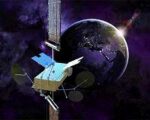In a rare and revealing sighting, two F-117A Nighthawk stealth aircraft were recently photographed refueling mid-air from a U.S. Air Force KC-46A Pegasus tanker. The event underscores the ongoing operational relevance of the retired stealth platform and highlights the integration of legacy systems with modern aerial refueling capabilities. The images, captured over Nevada on September 30, 2025, have reignited speculation about the secretive missions and roles assigned to these iconic aircraft long after their official retirement.
Rare Sighting Over Nevada
The photographs—first published by aviation photographer Santos Caceres—show two F-117s trailing behind a KC-46A during an aerial refueling operation near Tonopah Test Range Airport (KTNX), Nevada. One of the aircraft bore tail number 88-0841, confirming its identity as part of the original fleet of 59 production Nighthawks built by Lockheed under the “Have Blue” program.
This is not the first time F-117s have been seen in flight since their retirement in 2008. However, this marks one of the few publicly documented instances where they are seen operating with a next-generation tanker like the Boeing KC-46A—a platform that achieved Initial Operational Capability (IOC) in 2022 and is gradually replacing aging KC-135 Stratotankers.
Why Are “Retired” F-117s Still Flying?
The U.S. Air Force officially retired the F-117 in April 2008 following its replacement by more advanced fifth-generation platforms like the F-22 Raptor and later the F-35 Lightning II. Despite this, sightings have continued over test ranges in California and Nevada for more than a decade.
According to multiple defense sources—including USAF statements and budget documents—the Air Force maintains a small number of airworthy F-117s for limited flight operations under what is believed to be a classified or quasi-operational test program. These flights are reportedly conducted for purposes such as:
- Aggressor training against radar systems simulating low-observable threats
- Radar cross-section (RCS) testing for new sensors or missile seekers
- Tactics development involving stealth aircraft detection or counter-stealth methods
In fact, official documents obtained via FOIA requests show that at least four to six Nighthawks remain flight-capable under control of Detachment 1 at Tonopah Test Range Airport—a facility long associated with black projects and classified airframes.
Kansas-Built Tanker Meets Cold War Stealth Jet
The presence of a KC-46A Pegasus adds another layer of intrigue. Developed by Boeing based on its commercial 767 airframe, the KC‑46 offers significant upgrades over legacy tankers:
- Fly-by-wire boom system with remote vision capability
- Multi-point refueling via boom and hose-and-drogue systems
- Secure communications suite enabling networked C2 functions
The pairing suggests that either the Air Force is validating interoperability between legacy stealth platforms and modern support infrastructure—or that these flights are part of more complex exercises involving mixed-generation assets.
Tactical Implications and Training Roles
The timing coincides with Red Flag exercises at Nellis AFB as well as other known test events at Groom Lake (Area 51). While no official connection has been made public, it’s plausible that these sorties are supporting high-end training scenarios involving low-observable threats—either simulating adversary stealth platforms or validating counter-stealth tactics using U.S.-controlled assets.
Notably, some defense analysts speculate that F‑117s may be used to simulate Chinese J‑20 or Russian Su‑57 profiles during radar evaluation trials or electronic warfare testing. Their unique RCS signature makes them ideal surrogates for such missions without risking newer frontline assets.
Aging Platform Still Offers Value
The airframe itself remains structurally sound despite its age due to limited flight hours accumulated during service life—most missions were flown at night under peacetime conditions. Moreover, many avionics components have likely been updated or replaced with instrumentation tailored for testing roles rather than combat readiness.
This longevity allows them to serve niche but valuable roles within USAF’s test ecosystem—especially given growing concerns about peer adversary capabilities in radar denial and anti-access/area-denial (A2/AD) environments. As one retired USAF officer noted anonymously: “The airframe may be old—but its shape still fools radars.”
Status of Remaining Fleet and Future Outlook
The FY2024 NDAA authorized continued funding for limited operations of retired platforms used in developmental testing through FY2026. While no formal plan exists to reactivate F‑117s into combat service, their use as testbeds appears secure for now. Additionally:
- Around a dozen aircraft remain stored at Tonopah; several others were transferred to museums or scrapped under demilitarization protocols.
- No weapons carriage has been observed on recent flights; most appear clean-configured without pylons or targeting pods.
- Boeing’s KC‑46 program continues expanding globally—with Japan already operating several units—raising interoperability stakes across allied forces.
Conclusion: Ghost Jets Still Haunt Skies—for Good Reason
The recent sighting serves as another reminder that retirement doesn’t always mean obsolescence—especially when it comes to uniquely capable platforms like the F‑117A Nighthawk. Whether supporting sensor validation programs or standing in as threat surrogates during joint exercises, these ghost jets continue contributing quietly but effectively to U.S. military readiness—and now do so alongside next-gen enablers like the KC‑46 Pegasus.









